
A revolver is a repeating handgun that has at least one barrel and uses a revolving cylinder containing multiple chambers for firing. Because most revolver models hold up to six cartridges, before needing to be reloaded, revolvers are commonly called six shooters or sixguns. Due to their rotating cylinder mechanism, they may also be called wheel guns.

.22 Short is a variety of .22 caliber (5.6 mm) rimfire ammunition. Developed in 1857 for the first Smith & Wesson revolver, the .22 rimfire was the first American metallic cartridge. The original loading was a 29 or 30 gr bullet and 4 gr of black powder. The original .22 rimfire cartridge was renamed .22 Short with the introduction of the .22 Long in 1871.

The .32 S&W Long, also known as 7.65x23mm, is a straight-walled, centerfire, rimmed handgun cartridge, based on the earlier .32 S&W cartridge. It was introduced in 1896 for Smith & Wesson's first-model Hand Ejector revolver. Colt called it the .32 Colt New Police in revolvers it made chambered for the cartridge.
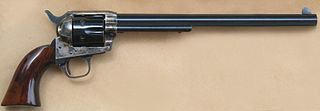
The Colt Buntline Special was a long-barreled variant of the Colt Single Action Army revolver, which Stuart N. Lake described in his best-selling but largely fictionalized 1931 biography, Wyatt Earp: Frontier Marshal. According to Lake, the dime novelist Ned Buntline commissioned the production of five Buntline Specials. Lake described them as extra-long Colt Single Action Army revolvers, with a 12-inch (300 mm)-long barrel, and stated that Buntline presented them to five lawmen in thanks for their help in contributing local color to his western yarns.
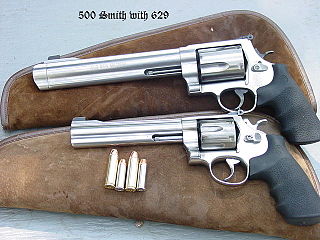
The Smith & Wesson Model 500 is a five-shot, double/single action large-caliber revolver produced by Smith & Wesson, firing the .500 S&W Magnum cartridge.
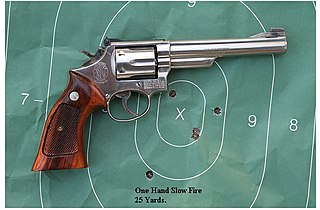
The Smith & Wesson Model 19 is a revolver produced by Smith & Wesson that was introduced in 1957 on its K-frame. The Model 19 is chambered for .357 Magnum. The K-frame is somewhat smaller and lighter than the original N-frame .357, usually known as the Smith & Wesson Model 27. A stainless steel variant of the Model 19, the Smith & Wesson Model 66, was introduced in 1971.

Metallic silhouette shooting is a group of target shooting disciplines that involves shooting at steel targets representing game animals at varying distances, seeking to knock the metal target over. Metallic silhouette is shot with large bore rifles fired freehand without support out to 500 meters, and with large bore handguns from the prone position with only body support out to 200 meters. Competitions are also held with airguns and black-powder firearms. A related genre is shot with bow and arrow, the metal targets being replaced with cardboard or foam. The targets used are rams, turkeys, pigs, and chickens, which are cut to different scales and set at certain distances from the shooter depending on the specific discipline.

NRA Precision Pistol, formerly known as NRA Conventional Pistol, is a national bullseye shooting discipline organized in the United States by the National Rifle Association of America. Emphasis is on accuracy and precision, and participants shoot handguns at paper targets at fixed distances and time limits. Other organizations in the United States and Canada have established rules and keep records of similar disciplines, including the Civilian Marksmanship Program (CMP) in the United States.

In American English, a pocket pistol is any small, pocket-sized semi-automatic pistol, and is suitable for concealed carry in a pocket or a similar small space.
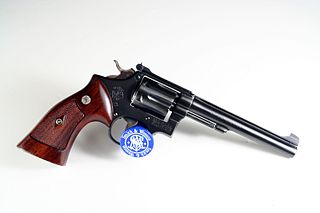
The Smith & Wesson Model 17 is a six-shot double-action revolver chambered for .22 LR. It is built on Smith & Wesson's medium-sized K-frame.
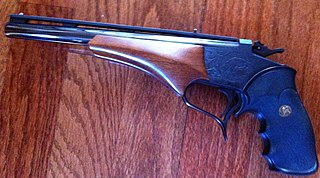
The Thompson/Center Contender is a break-action single-shot pistol or rifle that was introduced in 1967 by Thompson/Center Arms. It can be chambered in cartridges from .17 Bumble Bee to .45-70 Government.
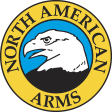
North American Arms is a United States company, headquartered in Provo, Utah, that manufactures pocket pistols and mini-revolvers, also called mouse guns. The company was originally named Rocky Mountain Arms when it was founded in 1972. In 1974 it was bought by new owners who renamed the company North American Manufacturing (NAM) and then North American Arms (NAA).

The Smith & Wesson Model 64Military and Police revolver is the stainless steel version of the Model 10.

S&W Centennial is a family of revolvers made by Smith & Wesson on the "J-Frame". Depending upon caliber, the cylinder holds either 5, 6, 7, or 8 cartridges. Centennials feature a fully enclosed (internal) hammer, which makes them Double Action Only (DAO) firearms. Like all other "J-frame" Smith & Wesson revolvers, they have a swing-out cylinder. Centennial models have been made in different versions like PD "Personal Defense", LS "Lady Smith", and M&P "Military & Police"

SIG Sauer of Newington, NH United States manufactures a full line of 1911 styled handguns. The earliest models were very faithful to the John M. Browning designed Colt M1911 Pistol which became the United States standard sidearm and served in that capacity for some seven decades before being replaced by the Beretta M9 handgun.

The Smith & Wesson Model 60 revolver is a 5-shot revolver that is chambered in either .38 Special or .357 Magnum calibers. It was the first revolver produced from stainless steel.

The Ruger SP101 is a series of double-action revolvers produced by the American company Sturm, Ruger & Co. The SP101 is a small frame and all-steel-construction carry revolver, with a five-shot ; six-shot ; or eight-shot cylinder.

The Smith & Wesson Model 640 revolver is a 5-shot snubnosed revolver that is chambered in either .38 Special or .357 Magnum caliber introduced in 1989. Like other "J-frame" Smith & Wesson revolvers, it has a swing-out cylinder, but this model features a concealed hammer, and is part of the Centennial line.
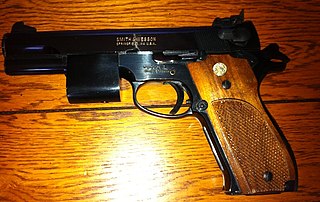
The Smith & Wesson Model 52, sometimes referred to as the 38 Master, is a semi-automatic pistol developed by Smith & Wesson for Bullseye shooting. It was one of the first semiautomatic pistols chambered in .38 Special with flush-seated, full wadcutter bullets. The shape of the rimmed cartridge limited the magazine capacity to five rounds. A variant, known as the Model 952, in 9 mm Parabellum, is still produced in limited quantities by Smith & Wesson's Performance Center. The Model 52 was discontinued in 1993 when the machinery to manufacture the pistol broke down and it was deemed too costly to replace.
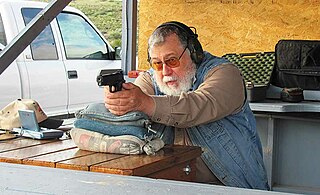
John August Taffin is an American author from Boise, Idaho who writes several columns for gun magazines including Guns, Gun Digest, Sixgunner, Shoot! and American Handgunner. A former math teacher from 1964 to 1995, Taffin is regarded as an authority on single-action revolvers, handloading, handgun hunting, big-bore revolvers, and metallic silhouette shooting. Taffin has authored five books and over 500 published articles. His monthly published gun columns include: Siluetas, Campfire Tales, The Sixgunner, and Taffin Tests.




















